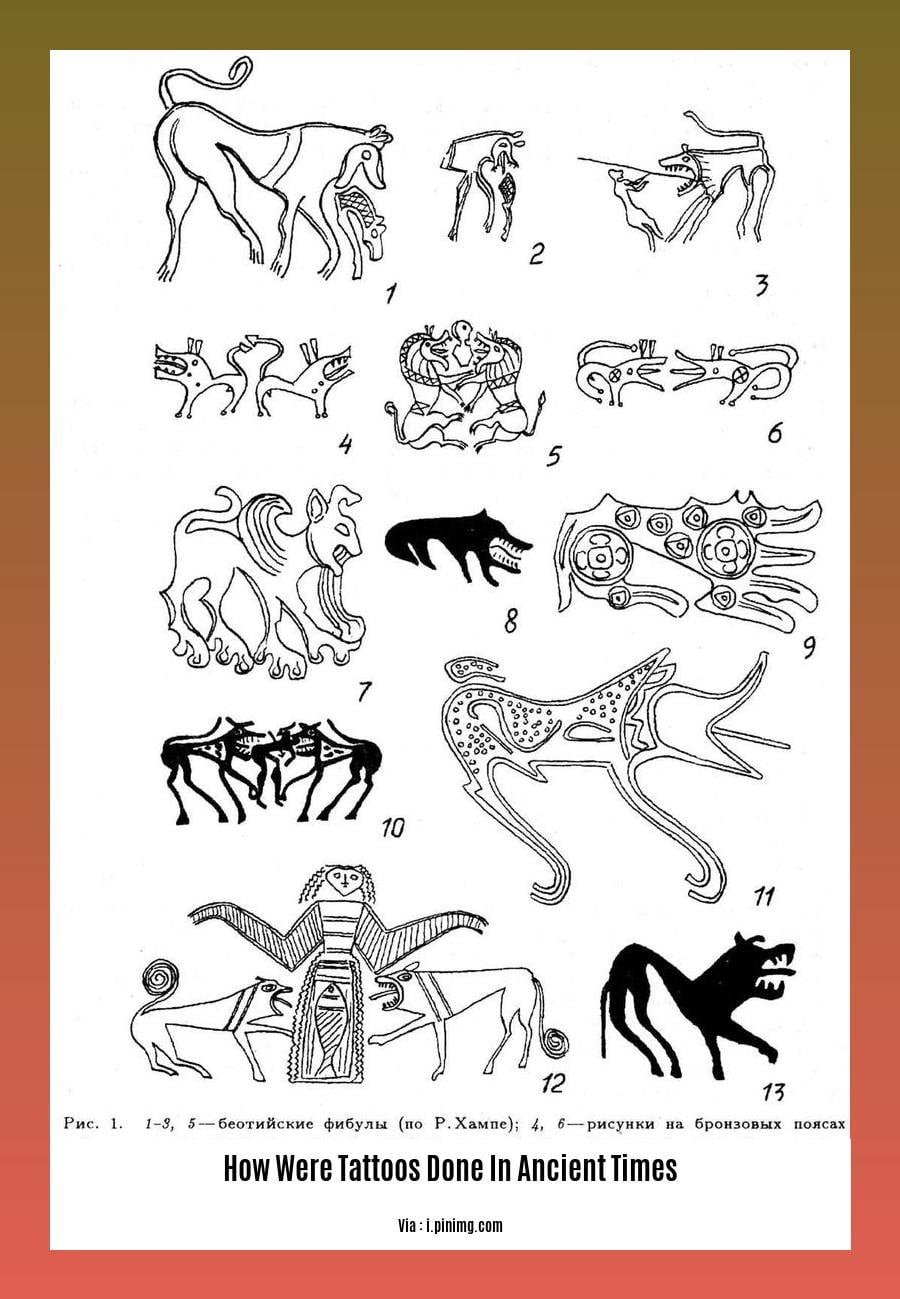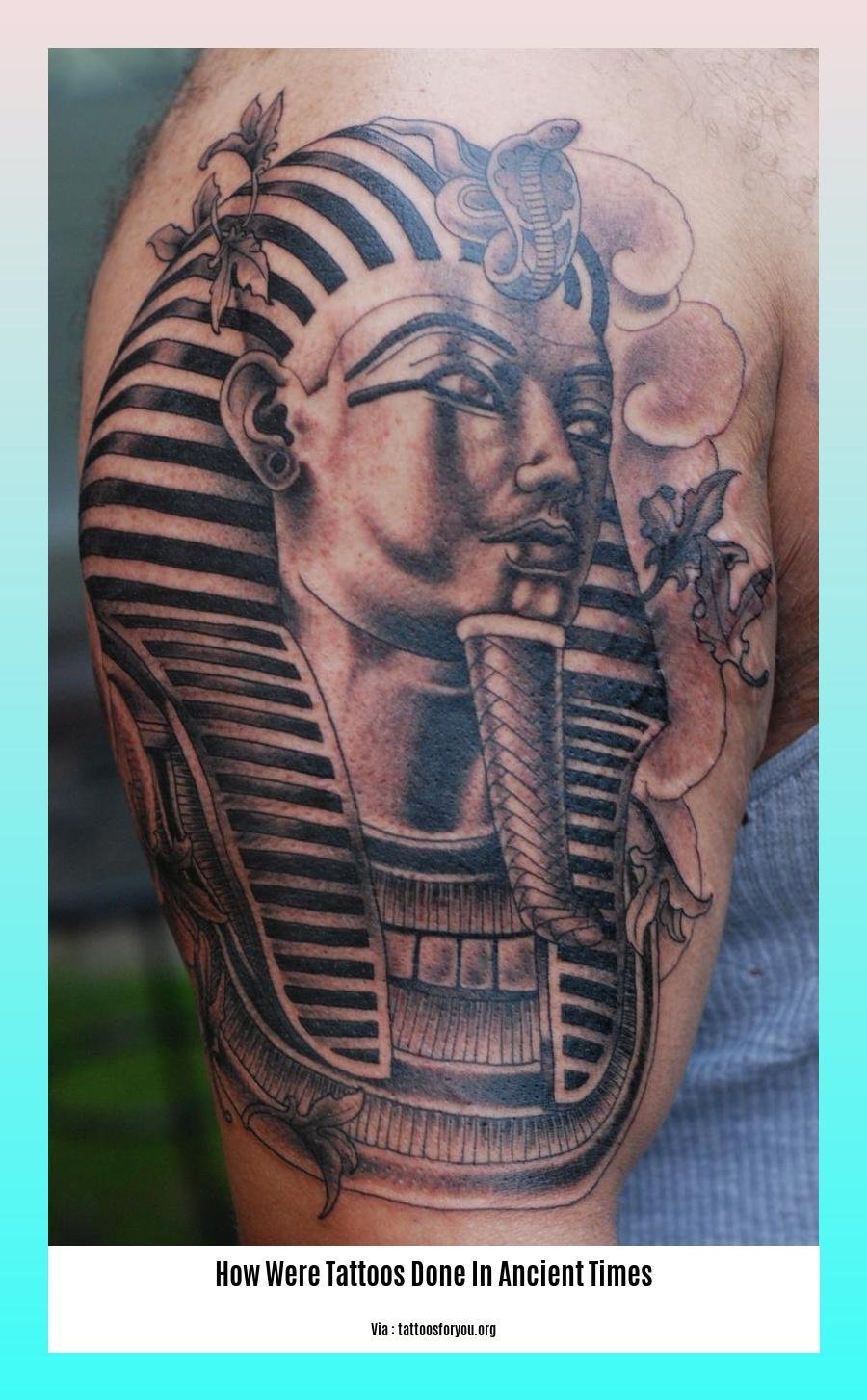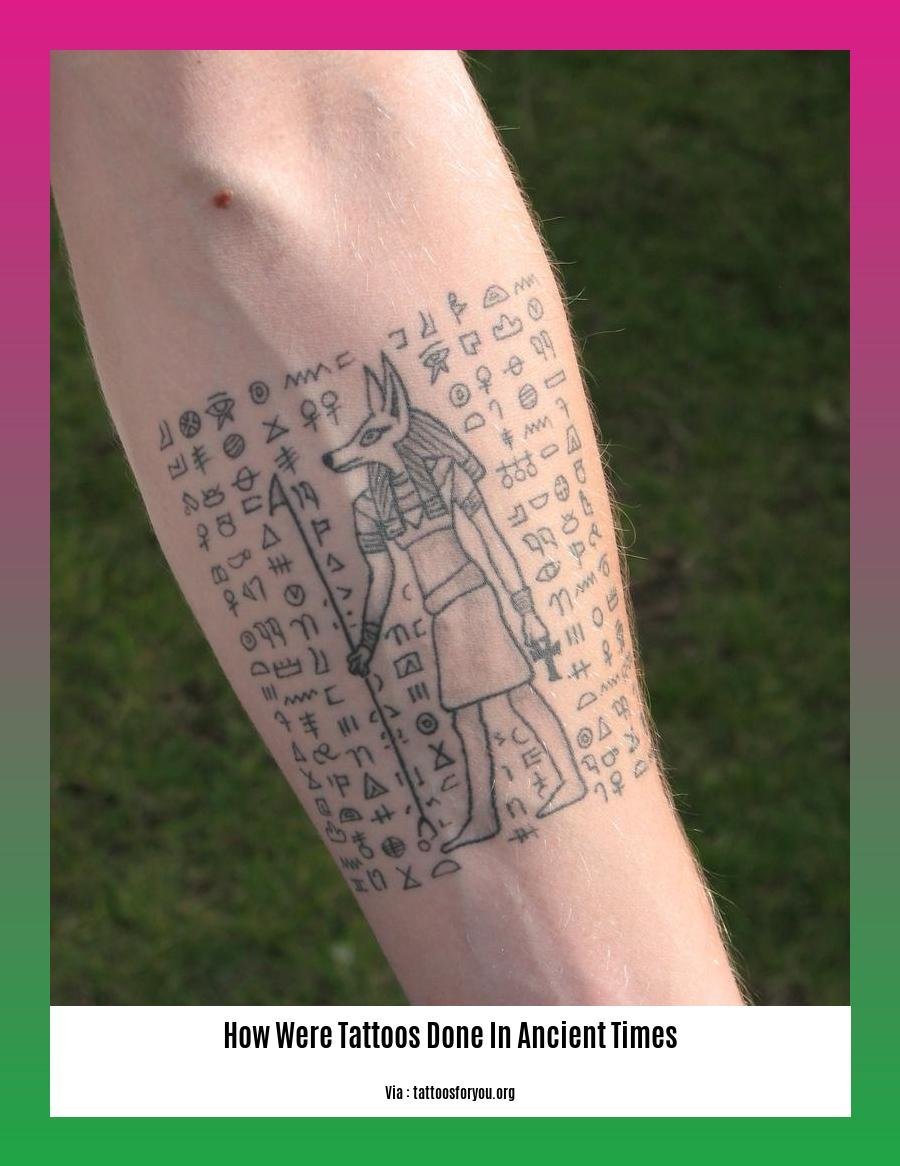Delve into the enigmatic world of ancient tattooing practices in our article [- How Were Tattoos Done in Ancient Times: Unveiling the Methods and Practices of Body Art]. Discover the captivating techniques and symbolic meanings behind the indelible marks that adorned the bodies of our ancestors. From the ancient Egyptians to the indigenous tribes of the Americas, we uncover the diverse methods used to create permanent body art in times long past.
KeyTakeaways:
- Ancient tattoos were created by scratching or pricking the skin and applying ashes or oil to the wounds.
- Tattooing was widely practiced among the Austronesian people originating in Taiwan.
- Tattoos often held deep cultural and spiritual meaning, representing tribal identity, social status, religious beliefs, or achievements.
- In ancient Egypt, tattooing was primarily reserved for women.
- Tattoos were not widely accepted in many cultures until the mid-20th century, being associated with marginalized groups like criminals and entertainers.
- In modern times, tattoos have gained popularity and acceptance as an art form and a means of self-expression.
Relevant URL Sources:
- Definitive History of Tattoos – The Ancient Art of Tattooing
- History of Tattoos: A Complete Timeline – AuthorityTattoo
**How Were Tattoos Done in Ancient Times: Unraveling Methods and Practices**

In ancient times, tattoos were created using rudimentary techniques and instruments, often reflecting cultural significance and beliefs. The process involved various steps and practices that have evolved over time.
Techniques of Ancient Tattooing
1. Scratching and Pricking:
– The earliest tattooing method involved scratching or pricking the skin with sharp tools such as needles made from bone, wood, or stone.
– The wounds were then filled with ashes, soot, or plant pigments to create a permanent mark.
2. Bone and Thorn Needles:
– In ancient Egypt, bronze needles were commonly used for tattooing.
– In other regions, needles made from bone, thorns, or sharpened sticks were employed.
3. Hammering and Chiseling:
– In some cultures, a mallet or chisel was used to forcefully puncture the skin and insert ink.
– This technique was particularly common in Southeast Asia and Polynesia.
4. Bamboo Sticks:
– Bamboo sticks were bundled together and sharpened to create a tattooing tool.
– This method was widely used in Southeast Asia and Japan.
5. Threading:
– Threading involved wrapping a thread soaked in ink around the needle and repeatedly puncturing the skin.
– This technique was used in Egypt and Africa.
Cultural Significance of Ancient Tattoos
- Tattoos often held deep cultural and spiritual meaning, varying across different societies.
- They could represent tribal identity, social status, religious beliefs, achievements, or protection.
- Some cultures believed tattoos possessed healing powers or marked significant life events such as adulthood or marriage.
Gender and Tattoos in Ancient Times
- In ancient Egypt, tattooing was primarily associated with women, as evidenced by mummified remains.
- However, later historical records suggest that men also received tattoos, though to a lesser extent.
- In some cultures, specific tattoo designs or placements were gender-specific.
Evolution and Acceptance of Tattoos
- Tattoos were not widely accepted in many cultures until the mid-20th century.
- They were often associated with marginalized groups such as criminals, sailors, and entertainers.
- In recent decades, tattoos have gained popularity and acceptance as a form of body art and self-expression.
The ancient art of tattooing has left a lasting legacy, with modern tattooing techniques and styles drawing inspiration from historical practices and cultural significance.
Curious about how the ancient Egyptians communicated with each other? Uncover the secrets of ancient Egyptian greetings and discover how they expressed themselves.
Intrigued by the enigmatic history of silk production in ancient China? Embark on a journey to uncover the ancient techniques and artistry behind the creation of this luxurious fabric.
Eager to explore the intricacies of ancient Egyptian language? Delve into the world of ancient Egyptian greetings and uncover the nuances of their verbal expressions.
Cultural Significance and Symbolism of Tattoos
In ancient times, tattoos transcended mere body art, carrying profound cultural and symbolic meanings. They weren’t just decorative; they were stories etched on skin, symbols of identity, status, and beliefs. Let’s delve into the captivating world of ancient tattoos and explore their rich cultural significance.
Key Takeaways:
-
Storytelling and Identity: Tattoos served as a form of storytelling, narrating the individual’s life journey, achievements, and tribal affiliations. They were like living chronicles, showcasing a person’s identity and heritage.
-
Social Status and Hierarchy: Tattoos often denoted social status, power, and hierarchy within a community. The designs, patterns, and placement of tattoos could indicate a person’s rank, profession, or accomplishments.
-
Religious Beliefs and Rituals: Tattoos played a crucial role in religious ceremonies and rituals. They were believed to possess spiritual power, protect against evil spirits, or facilitate communication with the divine.
-
Protection and Healing: Tattoos were sometimes used as protective symbols, warding off misfortune, illness, or harm. They were also believed to promote healing and recovery from injuries or illnesses.
-
Adornment and Beauty: While tattoos held deep cultural significance, they were also considered aesthetically pleasing. People adorned themselves with tattoos to enhance their beauty and express their individuality.
Cultural Examples:
-
Ancient Egypt: In ancient Egypt, tattoos were primarily associated with women. They symbolized fertility, beauty, and protection. Deities were often depicted with tattoos, and people believed that replicating these designs would bring divine favor.
-
Polynesian Cultures: Tattoos in Polynesian cultures held immense cultural and spiritual significance. They were a symbol of status, bravery, and identity. The intricate designs and patterns represented family lineage, achievements, and connection to the natural world.
-
Native American Tribes: Tattoos among Native American tribes varied widely, each tribe possessing unique designs and meanings. They symbolized tribal affiliation, social status, personal achievements, and spiritual beliefs. Tattoos were often associated with rites of passage, such as becoming a warrior or entering adulthood.
Tattoos Today:
Today, tattoos have evolved into diverse forms of self-expression and body art. While their cultural and symbolic meanings may have changed over time, tattoos continue to hold personal significance for individuals, representing their beliefs, values, and life stories.
Sources:
- World History Encyclopedia: Tattoos in Ancient Egypt
- Britannica: Tattooing
Historical Examples of Ancient Tattoos

In the annals of history, Historical Examples of Ancient Tattoos provide a fascinating glimpse into the diverse cultures and practices of our ancestors. From the intricate designs of ancient Egypt to the bold symbols of Polynesian tribes, tattoos have served as a means of self-expression, identity, and spiritual connection for millennia.
Key Takeaways:
-
Ancient Egypt: Tattoos held deep cultural significance, often depicting hieroglyphics, symbols of power, and religious motifs.
-
Polynesia: Tattoos were seen as a rite of passage, symbolizing bravery, status, and lineage. The intricate patterns and designs were believed to hold spiritual power.
-
Ancient Greece: Tattoos were associated with fertility and healing. Women often received tattoos to honor the goddess Artemis, while soldiers bore tattoos to protect themselves in battle.
-
Ancient Rome: Tattoos were primarily used as a form of punishment for slaves and criminals. However, some gladiators and soldiers also received tattoos to instill fear in their opponents.
-
Ancient Japan: Tattoos were initially associated with the lower classes, but gradually gained popularity among the samurai and aristocracy. They were seen as a symbol of strength, courage, and loyalty.
Unveiling the Techniques of Ancient Tattoos
In ancient times, tattooing was a meticulous and often painful process. Various techniques were employed, including:
-
Hand-poking: Using a sharp instrument to repeatedly puncture the skin and inject ink or pigment.
-
Scratching: Creating designs by scratching the skin with a sharp object and rubbing in ink or ash.
-
Cutting: Incising the skin and rubbing ink into the wound.
-
Hammering and Chiseling: A technique used in ancient Egypt, where needles were attached to a hammer and tapped into the skin.
-
Bamboo Sticks: In Southeast Asia, bamboo sticks were sharpened and used to puncture the skin and insert ink.
These methods were far removed from the modern, mechanized tattoo machines we have today, making the dedication and skill of ancient tattoo artists all the more remarkable.
The Cultural Significance of Ancient Tattoos
Beyond their aesthetic appeal, ancient tattoos held deep cultural and spiritual significance. They were often used to:
-
Denote Social Status: Tattoos could indicate an individual’s rank, occupation, or achievements within a community.
-
Mark Religious Affiliation: Tattoos were used to display devotion to specific gods or goddesses and were believed to offer protection.
-
Symbolize Rites of Passage: Tattoos marked important life events, such as coming of age, marriage, or entry into a new social group.
-
Protect Against Evil: In many cultures, tattoos were believed to ward off evil spirits, illness, or misfortune.
-
Enhance Fertility: Some cultures believed that tattoos could increase fertility or grant protection during childbirth.
Historical Examples of Ancient Tattoos offer a glimpse into the rich cultural heritage of our ancestors. These intricate designs and symbols provide a tangible connection to the past, reminding us of the enduring human desire for self-expression and connection to the divine.
Citations:
- History of Tattoos in Ancient Times
- Ancient Tattoos: A History of Body Art
Preservation of Ancient Tattoo Practices
Our ancestors used various tools and techniques to create tattoos that symbolized their culture, beliefs, and experiences. Delving into these ancient practices offers valuable insights into human creativity and expression.
Key Takeaways:
-
Ancient tattooing methods involved hand-poking, scratching, and cutting the skin to infuse pigment.
-
Tattoos signified social status, religious beliefs, acts of bravery, and were sometimes used to mark slaves and criminals.
-
Ötzi the Iceman bears the oldest evidence of preserved ancient tattoos discovered in the Alps.
-
Captain James Cook introduced the Tahitian word “tatau” to the English language in the 18th century, eventually becoming the word “tattoo.”
Instruments and Techniques
-
Bone, sharpened stick, and metal needles were common tools for tattooing.
-
Hand-poking: The skin was punctured repeatedly with a sharp object to create a design.
-
Scratching: A sharp tool was used to scratch the design into the skin.
-
Cutting: The skin was cut and ink was rubbed into the wound to create a tattoo.
Significance and Symbolism
-
Tattoos were more than just body art; they held profound cultural and symbolic meanings.
-
They were used to mark significant events, such as rites of passage, coming-of-age ceremonies, or achievements.
-
Tattoos could also symbolize religious beliefs, such as protection from evil spirits or connection to a deity.
-
Social status was sometimes indicated through tattoos, with specific designs reserved for individuals of high rank.
-
Tattoos were also used to mark slaves and criminals in some societies.
The Discovery of Ancient Tattoos
-
Ötzi the Iceman, a remarkably preserved mummy discovered in the Alps in 1991, bears the oldest known tattoos.
-
His tattoos, dating back to 3250 BCE, provide valuable insights into ancient tattooing practices.
-
Other archaeological discoveries have revealed tattooed mummies in ancient Egypt and Peru, offering further evidence of the widespread practice of tattooing in ancient times.
Conclusion
Ancient tattoos offer a fascinating glimpse into the lives and cultures of our ancestors. From the tools and techniques they used to the meanings and symbolism behind their designs, these tattoos provide a tangible connection to the past. Preserving and studying ancient tattoo practices help us understand the rich tapestry of human history and cultural expression.
Citations:
- HistoryDisclosure: How Did They Do Tattoos in Ancient Times?
- National Geographic: Tattoo History and Timeline
FAQ
Q1: What methods were used to apply tattoos in ancient times?
A1: Ancient tattooing techniques varied depending on the region and time period. Common methods included hand-poking, scratching, and cutting the skin to create a design, followed by the application of ink or pigment. In ancient Egypt, needles made of bone or metal were used to puncture the skin and insert ink.
Q2: Did tattoos have specific meanings or purposes in ancient cultures?
A2: Yes, tattoos often held deep cultural and social meanings in ancient societies. They could signify tribal identity, social status, religious beliefs, acts of bravery, or transitions in life. Tattoos could also be used for therapeutic purposes, protection, or as a sign of mourning.
Q3: Can you provide examples of ancient cultures where tattoos were prevalent?
A3: Ancient cultures with notable tattooing practices include the Austronesian people, originating in Taiwan and coastal South China, as well as the ancient Egyptians and Japanese. Tattoos were prevalent among various societal groups, including women and men, and served diverse purposes within these cultures.
Q4: What is the oldest known evidence of tattoos on ancient people?
A4: The oldest known tattooed mummy is Ötzi the Iceman, discovered in the Alps and dating back to 3250 BCE. His body bears intricate tattoos believed to have therapeutic and protective purposes. Ötzi’s tattoos provide valuable insights into tattooing practices during the Chalcolithic period.
Q5: How have tattooing practices evolved over time, and what is the current perception of tattoos in modern society?
A5: Tattooing practices have undergone significant changes over time. In many cultures, tattoos were once associated with marginalized groups or seen as taboo. However, in recent decades, tattoos have gained widespread acceptance and popularity as a form of self-expression and body art. Tattoos are now appreciated for their artistic and cultural value, and their social stigma has largely diminished.
- Unraveling Einstein’s Legacy: Who Inherited His Genius? - July 14, 2025
- Unlock Einstein’s Family Tree: Bernhard Caesar & Untold Stories - July 14, 2025
- Unveiling Bernhard Caesar Einstein: His Life & Albert Einstein’s Legacy - July 14, 2025
















